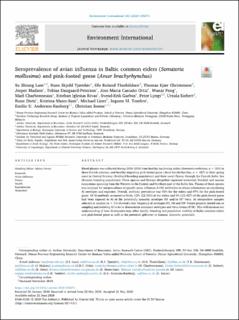| dc.description.abstract | Influenza viruses are negative-sense single-stranded RNA viruses within the family of Orthomyxoviridae (Alexander, 2008). It holds Influenza A, B, C and D. Influenza A, B and C cause disease in humans, while only Influenza A viruses infect birds including waterfowl (Giwa et al., 2020, Lycett et al., 2019). The classification of Influenza A is based on profiling of surface proteins hemagglutinin (HA) and neuraminidase (NA), which divide the viruses into 18 and 11 subtypes, respectively (Giwa et al., 2020, Lycett et al., 2019). Waterfowl are considered a main reservoir of Avian Influenza (AI) A viruses with both low (LPAI) and high (HPAI) pathogenic subgroups; the latter causing disease outbreaks in both domestic and wild birds (Su et al., 2017, Beerens et al., 2020). So far, only H7 and H5 have been associated with HPAI, but they are not always pathogenic or cause clinical disease (Alexander, 2007). HPAI occurrence has far exceeded LPAI in flocks of wild birds although relative frequencies vary on a regional scale (Alexander, 2007, Pohlmann et al., 2019). AI appears to have the ability to infect most bird species, with the highest isolation rates found in waterfowl and birds from the Anatidae family which are more frequent hosts than any other family of birds (Stallknecht and Shane 1988).
Pink-footed geese and common eiders are long-distance migratory bird species that carry AI and thus represent a potential for spreading the virus over wide geographical ranges (Harris et al., 2010, Hoye et al., 2011, Pasick et al., 2007). Moreover, the finding of influenza A in seals shows the virus’ potential to cross wide species barriers (Bodewes et al., 2013, Krog et al., 2015).
Eiders occurring in Denmark are part of the Baltic/Wadden Sea flyway population, and has declined by 36% over the past decades (Christensen et al., 2013; HELCOM, 2013, Waltho and Coulson, 2015). In addition, pink-footed geese, likely due to environmental and climatic changes, have developed novel flyways into the Russian Arctic through Finland. Therefore, these two species are particularly appropriate for the monitoring of AI in wild Anatidae in the Baltic. The aim of the present study was therefore to investigate AI seroprevalence including occurrence of subtypes H5 and H7 in Baltic common eiders and pink-footed geese. These two species enable a broad coverage of Baltic terrestrial, brackish and marine ecosystems spanning from the Western to the Eastern and Northern parts of the area. Samples from three Danish eider colonies and migrating pink-footed geese were selected for study. The geese were sampled when they arrived from Denmark at their spring roost in Central Norway (Svalbard breeding population) and at their new flyway in the Finnish Baltic Sea (Russian breeding population). This is the basis for assessing environmental AI exposure in two Baltic key-species. | en_US |

